 |
| From 41st Lunar & Planetary Science Conference (2010) - |
The history of the Moon is the history of Earth, and the testimony of the Moon is saturation bombardment. The history of the inner solar system is recorded there also, safe far from the dynamic lithosphere and atmospheric erosion ever-present here on Earth. Even before the preliminary glance (above) at laser altimetry from LOLA, on-board LRO, was presented, 300 impact basins were already identified on the Moon. Most are not as apparent as the familiar "basin-forming impacts" visible to the naked eye, clustered on the Moon's near side (on the left side of the projection of the Moon's eastern hemisphere above). Was a gradual fall-off in both the size and frequency of impacts on the Moon, preserved over 4.5 billion years, steady or were there peaks and valleys in that long process? If so, what caused those events, and how often? Are they cyclical? The Moon holds the answers, a convenient recording of Earth's past. Almost certainly, our companion Moon will tell us something about Earth's future, also [NASA/GSFC].
Barbara A. Cohen
NASA Marshall Space Flight Center (MSFC)
The bombardment history of the Earth-Moon system has been debated since the first recognition that the circular features on the Moon may be impact craters. Because the lunar impact record is the only planetary impact record to be calibrated with absolute ages, it underpins our understanding of geologic ages on every other terrestrial planet.
One of the more remarkable results to come out of lunar sample analyses is the hypothesis that a large number of impact events occurred on the Moon during a narrow window in time approximately 3.8 to 4.1 billion years ago (the lunar “cataclysm”).
Subsequent work on the lunar and martian meteorite suites; remote sensing of the Moon, Mars, asteroids, and icy satellites; improved dynamical modeling; and investigation of terrestrial zircons extend the cataclysm hypothesis to the Earth, other terrestrial planets, and possibly the entire solar system. Renewed US and international interest in exploring the Moon offers new potential to constrain the Earth-Moon bombardment history.
This paper will review the lunar bombardment record, timing and mechanisms for cataclysmic bombardment, and questions that may be answered in a new age of exploration.
One of the more remarkable results to come out of lunar sample analyses is the hypothesis that a large number of impact events occurred on the Moon during a narrow window in time approximately 3.8 to 4.1 billion years ago (the lunar “cataclysm”).
Subsequent work on the lunar and martian meteorite suites; remote sensing of the Moon, Mars, asteroids, and icy satellites; improved dynamical modeling; and investigation of terrestrial zircons extend the cataclysm hypothesis to the Earth, other terrestrial planets, and possibly the entire solar system. Renewed US and international interest in exploring the Moon offers new potential to constrain the Earth-Moon bombardment history.
This paper will review the lunar bombardment record, timing and mechanisms for cataclysmic bombardment, and questions that may be answered in a new age of exploration.
View the presentation (pdf), HERE.

No comments:
Post a Comment